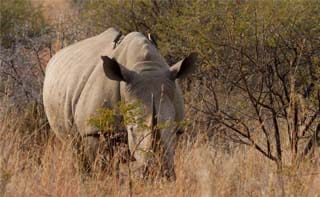Rhinoceros in Pilanesberg

Characteristics
The white rhinoceros is the larger of the two species and its shoulders reach a height of about 1.8 metres with a weight of about 2 tons. The black rhinoceros reaches a height of 1.6 metres and a weight of 1.5 tons. The names of the two species are misleading as they do not describe the colour of the animals. The shape of the white rhinoceros’ lips was describes as “wijd” by the first Dutch settlers in South Africa. “Wijd” means wide in English but a mistranslation gave the name “white rhinoceros” to the square-lipped rhino and in accordance the hook-lipped rhino was named “black rhinoceros”.
At first sight the appearance of the two rhino species is very similar, but at a second glance white and black rhino are quite easily distinguished. The white rhinoceros is the larger species and is a grazer. The flat lip and a mostly low-hanging head aid this feeding habit. The black rhino is a browser, which means that it feeds on shrubs and fruit above the ground. The pointed lip helps the animal grab food with its mouth. Finally the white rhino has a lump on its neck that the black rhinoceros lacks.
Behaviour
The white rhino occurs in larger numbers in Pilanesberg National Park and is not as endangered as the black rhino, but both species are threatened by poaching. Rhino horn is falsely believed to have medicinal purposes and hence poachers kill rhinos solely for the purpose of taking their horns. Saving the future of both black and white rhinoceros is one of the major conservation challenges of our time.
